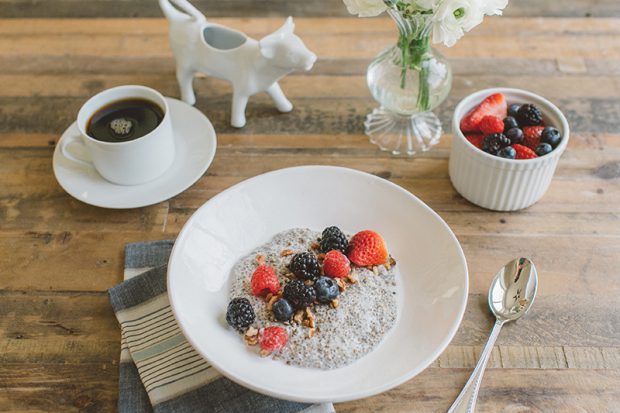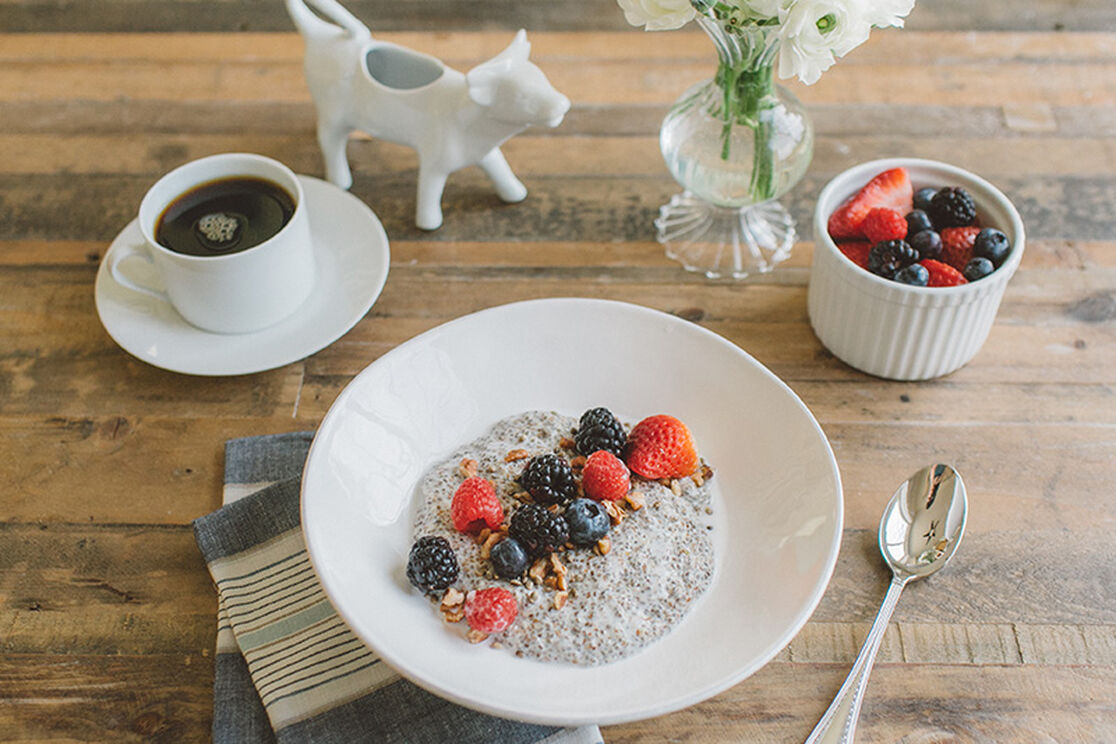Tell us a little bit about yourself and how you’re working to free people of food drama
I started my nutrition consulting business in 2012 as a side-hustle while I was working in a full-time corporate career in cancer and genetics. So I've always been in the health and wellness space, and even before that I used to read diet and health books for fun when I was young. In 2015 I decided to take Be Well by Kelly full-time and left my corporate career to grow my business. My clients range from high profile actresses getting ready for a big movie role, to brides getting ready for a wedding, or even people dealing with a chronic or autoimmune diseases. I also wrote my first book, Body Love which came out in 2017, and my second book is set to come out in January 2019.
I work with clients to help them learn how to eat in a way that makes them feel full, elongates their blood sugar curve, and makes sure they have the nutrients they need to feel great throughout the day. I'm working to help free people of food drama because eating well shouldn't be complicated. When you understand how the food you put on your plate and into your body can set you up for success (or not) then you're free to make the best choices for yourself. No need to obsess over every meal; it's all about creating light structure that works so you can focus all of your energy on the amazing things happening in your life.
Your book Body Love uses science-backed techniques and Body Love is about so much more than losing weight. Let’s talk about that:
Because my nutrition approach is science-based and not a fad diet, it means that we're talking about learning to eat in a way that not only can help you burn fat and lose weight, but also help you have better energy levels and manage cravings. But it's not just about the physical benefits — I want my clients to have peace of mind and let go of the guilt or anxiety that comes with food. This happens when you learn the tools you need to feel confident when you're ordering off of a restaurant menu and can trust yourself because you know what your body needs.
I think women especially feel so much pressure to eat a certain way or weigh a certain amount, but we also want to enjoy our lives. Giving people the tools they need to be able to eat in a way that makes them feel great is so important. No one wants to feel deprived or like they can't ever have a glass of wine or pizza. That's just not real life. But knowing that you have a tool like the Fab Four smoothie in your arsenal to help you get back on track the morning after you indulge in that birthday cake or pizza is going to help them feel more empowered and confident. Understanding nutrition and how your body works is one of the best things you can do to live your best life and feel confident about the choices you make every day.
What is the Fab Four?
The Fab Four is a light structure lifestyle that helps you prioritize putting 4 healthy essentials on every plate; protein, fat, fiber and greens. You want to make sure you have these four things in every meal, so ideally a good quality protein source—like organic, free-range or grass-fed meat, sustainably caught fish, pasture-raised eggs or a great collagen protein in your smoothie. If you're plant-based or vegetarian, then you include plant-based pea protein, nuts/seeds or beans. The fat (i.e. avocado or almond butter), leafy greens (like spinach or arugula), and fiber (i.e. flax seeds, broccoli) all work together to turn off your hunger hormones and elongate your blood sugar curve so you feel full, calm, and have the energy you need throughout the day.
I created the Fab Four because it's a simple strategy to use to make sure you're getting what you need in every meal to feel balanced, satisfied and calm—no calorie counting, macro counting or math required. Once you get the Fab Four down and you're good to go because you know how to feel full for 4-6 hours, and you won't have to waste time worrying about what you should eat. We have so many decisions to make in a day, and the Fab Four is one way to help reduce the overwhelm.
Why is fiber so important?
Fiber is so important for a number of reasons, especially for gut health and to help manage blood sugar. Fiber helps food move through our digestive system and helps get rid of toxins in the body as well and double the release the satiety hormone, CCK.
You can find fiber in veggies like cucumber, cauliflower, zucchini, broccoli and brussel sprouts. It's also found in fruit, seeds, nuts and avocados which are a good source of fat and fiber! You can also add a fiber like flax seed, acacia fiber, or chia seeds to smoothies to bump up the fiber content.
We've all heard about the benefits of gut-health and taking probiotics, which is great, but you also need fiber to help the good bacteria bacteria in your gut do its job. Another thing fiber can help with is produce a fatty acid called butyrate which acts like a "superfat" for the gut and helps prevent cancer and inflammation.
What’s the science behind how fiber helps to keep you full longer?
Fiber helps slow the absorption of glucose (blood sugar) in your body which means you'll have a longer blood sugar curve, without extreme highs and lows. On the other hand, when your blood sugar spikes high from eating sugar or processed carbohydrates (also known as Acellular Carbohydrates) your insulin levels can rise quickly causing a crash and subsequent hormonal cravings for sugar/carbs soon after. Whole foods, (also known as, cellular foods) keep their plant sugars wrapped in fiber cells that naturally slow the release of sugars and prevent that cycle.
When you're not eating enough fiber, or enough of the essential nutrients your body needs, you can be eating a larger volume of food but not feel full. Fiber is one reason why you feel totally different if you drink a green juice for breakfast vs. a green smoothie that has fiber and fat and protein, plus greens. Chances are if you just have a fiber-less juice for breakfast, you're white-knuckling it until your next snack or meal.
How do you get fiber?
It's harder than you think! Our ancestors used to get an average of 100 grams of fiber a day and today the average for most Americans is only 15 grams.
Ideally you get lots of fiber from whole foods like broccoli, cauliflower or fiber rich fat sources like nuts, seeds and avocado. But you can also get extra fiber from adding it to your smoothies and recipes with chia seeds, acacia fiber, or flax seed.
Note: many assume leafy greens are a good source of fiber but most only provide a gram or less per cup so don’t forget to add cucumber, asparagus, artichokes and other fiber-rich non starchy vegetables to your salads to get the fiber you need!
What’s the difference between fiber and carbs?
Basically, a complex or cellular carbs that are "wrapped" in fiber and more difficult to break down. Consuming carbs "wrapped" in fiber is good because it slows the digestion of the carbs and helps keep blood sugar levels steady. Simple or acellular carbs are processed, just ask yourself “was this made with flour or sugar?” both have been removed from their fiber cells.
Some carbs contain fiber and others do not but it’s important to note that fiber doesn’t have an effect on blood sugar. Depending on the type fiber can either; feeds probiotic bacteria (soluble fiber) or help bulk and move bowels along (insoluble fiber). When comparing carbohydrates compare net carbohydrates (total carbohydrates (-) minus fiber) to ensure a more accurate understanding of how that specific food might affect blood glucose. The higher the fiber the less effect on blood sugar.
Do you have a go-to high-fiber recipe?
One of my favorite high-fiber recipes is my Warm Chia Flax Pudding. I call it "fo'meal" since it's similar to oatmeal, but grain-free, high-fiber, and lower in carbohydrates. Flax, chia and hemp seeds are lower net carbs than oats with more protein, fat and fiber to keep you full and provide the essential nutrients your body needs. It's really yummy with vanilla protein or collagen powder as a sweetener, and you can add your favorite toppings like nuts or berries (I recommend you keep the berries to a ¼ cup serving).

Chia Flax Hot Pudding (FO’ MEAL)
1 tbsp ghee or coconut oil (vegan)
2 cups unsweetened coconut or almond milk
3 tbsp chia seeds
2 tbsp ground flax seed
3 tbsp hemp hearts
Optional Toppings:
4 tbsp chopped pecans
2 tbsp hemp seeds
1/4 cup mixed fresh berries
Choose Sweetener:
1 serving Primal Kitchen Vanilla Collagen Fuel Protein (Keto - preferred)
3 stevia drops (keto)
1. In a medium nonstick fry pan on medium heat, add 1 tbsp. of ghee, 1 cup of coconut milk, chia seed and flax.
2. With a silicone spatula or wooden spoon, continuously stir all ingredients until pudding is thick about, 3 minutes.
3. Pour warm pudding into a bowl, option to stir in sweetener of choice.
4. Top with nuts, hemp seeds, coconut milk, and berries.
Serve Warm
IMAGES: https://honest.box.com/s/u1gctvwihpasntlfxlzqdi136xdvnsf6
We aim to provide you with the most honest and credible information possible. This article was reviewed for accuracy by The Honest Team and was written based on sources that are linked at the bottom of the article.
blog_review_statement



